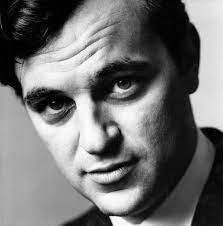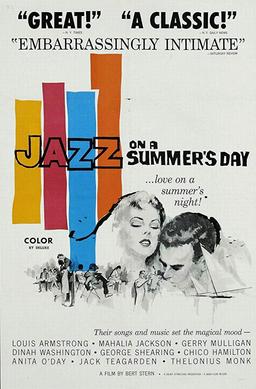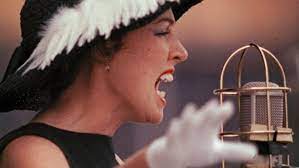
Bert Stern was “intrigued” and “amused” by the juxtaposition of “rich and poor,” as in rich Newport, poor jazz, when he decided to shoot a movie around the Newport Jazz Festival in 1958. But outside of a few scenes in which Thelonious Monk and others are heard against a backdrop of the America’s Cup trials in Newport harbor, there’s very little of a contrasting or ironic nature depicted in Jazz on a Summer’s Day. And even though it rained on the festival on Saturday night, the only storm cloud on the horizon in this sunny documentary is Chuck Berry, who enthralled the crowd and puzzled his accompanists in the hastily assembled Newport Blues Band. One of the most indelible images I carry from the film is the bemused look on the faces of Jo Jones, Buck Clayton, and Jack Teagarden as they back him on “Sweet Little Sixteen.”

Newport has seen its share of watershed moments, Duke Ellington’s 1956 appearance being foremost among jazz artists; Miles Davis’s 1955 performance of “Round Midnight” led to his signing by Columbia Records; Muddy Waters at Newport, recorded in 1960, brought the bluesman his first substantial sales among white record buyers; and, of course, Bob Dylan went electric at the Newport Folk Festival in 1965. The jazz festival also witnessed riots in 1960 and ‘71, but even though the audience kept its frenzy in check for Chuck Berry, booking him marked a demarcation line between a festival devoted exclusively to jazz and what its founder George Wein describes as a “capitulation to the pressures of a rock-and-roll generation.”
Wein reports that it was John Hammond who produced the Saturday night blues showcase that included Berry. Hammond had presented a panoply of jazz, blues, gospel and boogie woogie greats at the groundbreaking Spirituals to Swing concert at Carnegie Hall in 1939. But the guitar slinger from St. Louis was another matter. “I was dead set against Chuck Berry,” Wein recalled in his memoir My Life With Others. “Rock and roll…did not belong on the Newport Festival…When he went into his duck walk, I literally cringed. I could almost feel the [critics’] knives…Needless to say, the crowd loved it… [And] the grand irony is that putting [him] on at Newport was a daring move that led to similar presentations all over the world. So I get credit for being a visionary…but John deserves the credit. Incidentally, I’ve grown to like Chuck Berry’s music.”
https://youtube.com/watch?v=tcK0HcovzTA
Well, who hasn’t? Surely Big T and Papa Jo would have recognized Berry’s roots in the blues, and seeing the spirited buck and wing that a poplin-suited gent cuts while Chuck sings his ode to the girl “in tight dress and lipstick” underscores how much his music was rooted in the same vernacular as jazz. But in this case, one man’s vision may be another’s slippery slope, and the apparently irreversible trend we’ve seen in de-emphasizing jazz at so-called jazz fests began at Newport on July 6, 1958. Newport fests went on to feature major rock acts in the ‘60’s and early ‘70’s; I was present on Friday night and Saturday afternoon of the ’71 fest, but felt the vibes and got on the road before a storming of the gates during Dionne Warwick’s evening set shut the festival down and sent it looking for a new home. A pleasing reversal of Wein’s “capitulation” is that the festival he re-established at Fort Adams State Park in Newport in the 80’s is a jazz purist’s delight, and a big draw.

One heartening element of the festival documented in Jazz on a Summer’s Day is that Louis Armstrong was still its top-dollar centerpiece; Stern says his appearance in the movie ate up $25,000 of its $115,000 budget. Pops is shown playing “Lazy River,” “Tiger Rag,” and “Saints,” and Teagarden joins him for their classic duet on “Rockin’ Chair.” The film also captures a perky Anita O’Day singing “Sweet Georgia Brown;” Dinah Washington joining Terry Gibbs with a pair of mallets for a vibes solo on “All of Me;” Sonny Stitt and guitarist Sal Salvador playing Stitt’s “Blues Up and Down” at breakneck tempo; Gerry Mulligan’s great quartet with Art Farmer playing “Blueport;” and the first widely seen footage of two disparate icons, Eric Dolphy, who’s there with Chico Hamilton’s Quintet, and Mahalia Jackson, who’s seen here singing “Everybody’s Talkin’ ‘Bout Heaven,” “Didn’t It Rain?” and “The Lord’s Prayer.”


Willis Conover, the legendary jazz host of the Voice of America, emphasizes that it’s “after midnight” when he introduces Mahalia on Saturday night. The gospel great was reluctant to appear on a bill devoted to blues, but she agreed with Wein’s proposal that she come on to “welcome Sunday morning.” Jackson was at the festival to sing “Come Sunday” with the Duke Ellington Orchestra, but neither Ellington nor Miles were included in the film. (Their sets, however, were released on Columbia LP’s.)
Jazz on a Summer’s Day was added to the Library of Congress National Film Registry in 1999, and the detailed interview Stern gave for the occasion is reprinted in the DVD reissue of the documentary. Stern, a renowned fashion photographer who shot Marilyn Monroe in the nude, allows that he knew very little about jazz in the mid-‘50’s, so he recruited Columbia Records executive George Avakian as his music consultant and entrusted all of the decisions about who to film and what to include in the movie to him. (Avakian’s brother Aram served as the film’s editor.) Using innovative techniques like tight shots from very long lenses, Stern effects a stunning intimacy with the performers. The film closes with a credit to Avakian as Musical Director of the documentary, and no mention of Wein, who misread it as giving Avakian credit for the festival. Wein took this as “more than a slight; it was an insult,” and says he was “so offended that for years I didn’t extend a hand of friendship to George Avakian,” but goes on to express regret “because we might have been good friends.”


(George Wein) (George Avakian)
Notwithstanding this bitter memory, Wein praised the film. “The technical aspect was sensational, and the color photography was striking,” he wrote. “This sort of documentary was still a new thing in 1958, and jazz had never been presented this way on screen before.” Indeed, Stern’s “impression of jazz was…something downstairs in a dark room. This [movie] brought jazz out into the sun and it was different,” the filmmaker reflected. Actually, “into the sun” had been Wein’s doing with the creation of the Newport Jazz Festival in 1954, but credit Stern with immortalizing the images of these artists whom Duke Ellington called “night creatures” in glorious living color.
(Jazz on a Summer’s Day is the final presentation in this season’s Joy of Sax film series. Purchase tickets here for the April 9th screening at Amherst Cinema.)